Summary
The Solar Bubble Blaster is the first super capacitor enabled bubble blower to be powered by the sun. Saving the earth, one bubble at a time, there are no batteries required.
Background
This summer time project was done with my grandchildren. Our objectives were to learn about converting solar energy into useful "work" and have fun. With the exception of the hacked bubble blower all of the components were things I had in my junk box and parts cabinet. The project ended up working better than expected.
Development
I had a small solar panel rated at 0.5W, 6V that I picked up at the local Radio Shack when they went out of business and were selling inventory at a discount and a small inexpensive water pump we started with. As expected, the solar panel could not power the pump by itself so we added some super capacitors (two 1F and a 2F) that I had collected over time. A 5.1 V Zener diode was used to control the voltage so that the 5.5 V rating of the super capacitors was not exceeded.
Having successfully demonstrated that the super capacitors could power the pump for at least a short period of time we began collecting additional data for an IV curve using 1% tolerance resistors as a load.
Data was taken on a beautiful sunny day here in Seattle around 15:00 at a temperature of 21 degrees C with 48 % humidity. The panel was not optimally aligned with the sun. The open circuit voltage was around 6.6 V and the flat part of the curve at about 44 mA. The maximum power point (MPP) occurred just over 5V under these conditions and the panel generated about 0.22 W.
The data was scattered and I wanted to go back and repeat data collection with different panel alignment but the kids had lost interest and had gone off to blow bubbles with their grandmother. This gave me the idea to power a bubble machine and I found and purchased a “Blitz” Light-up Bubble Blaster on sale for $3.99.
Preliminary Design
That night the Bubble Blaster was dissected to see how it worked and it turned out to be a very interesting device. Disassembly was easy since screws were used throughout. The main mechanism is shown in the photo below.
Three alkaline 1.5 V batteries provide the power. The trigger serves as a switch and powers the small motor directly. A ceramic capacitor is soldered across the poles of the motor. A worm gear is attached to a shaft on the bottom of the motor and drives a gear mechanism with a peristaltic pump for the bubble solution. The bubble solution is pumped to a serrated aperture at the front of the gun. Another gear mechanism at the top of the same motor drives a fan which blows bubbles out of the aperture. Also visible are red and white wires which are attached to a “blob” which controls the LEDs. All for $3.99!
I hooked up the Bubble Blaster to my bench power supply with voltage set to 4.5 V and measured around 330 mA current with no soap solution being pumped. Wires were then soldered to the positive and negative battery contacts so they could be connected to a breadboard. The solar panel was also connected to the breadboard along with the super capacitors and a 5.1 V Zener to control voltage.
In the photo we see that the solar panel is charging the super capacitors up to 5.24 V. After playing around with it a bit we found that to get good performance all three super capacitors were required. In the past I had measured the actual capacitances and found them to be at the low end of their ratings (especially the inexpensive 1F rated ones from China) and I suspect actual capacitance of the three in parallel is something around 2.5F. There is frequently a -30% tolerance on these capacitors but I don't have a datasheet for the 1F capacitors.
Fabrication and Lab Test
That evening I soldered the following circuit on a small piece of protoboard cut to size.
The IN4148 diode prevents the super capacitors from discharging back through the solar panel when there is reduced light. The 5.1V IN4733A Zener (+/- 5%) sets the voltage to the super capacitors at a measured 5.25 V and also serves as a snubber diode for back EMF protection from the motor when the trigger switch is opened. All three capacitors are in parallel. The motor wiring and LED wiring was left unchanged.
Sometimes a current limiting resistor is added in the circuit above but I did not see a reason for it in this case. To better understand how it behaved an oscilloscope was connected and the circuit charged up with a bench power supply. The power supply was then disconnected for the test shown below so that only the super capacitors are providing power.
The vertical divisions are at 500 mV and the starting voltage is 5.26 V. The horizontal divisions are 50 ms. When the Bubble Blaster trigger is pulled the inrush current causes the voltage to drop to almost 3.5 V. It then begins to recover while showing a lot of noise. After approximately a second when the trigger is released there is immediate recovery to about 4.5 V with additional slow recovery afterwards. From this I decided the circuit was performing OK, at least for a toy.
The battery compartment was hollowed out and the super capacitors and new circuitry inserted. Enough plastic was left so that the batteries could still be reinstated should that be desired in future. The device was reassembled, the solar panel hot glued to the top, and everything made ready for field testing. Preparation included priming the pump with power from the bench power supply and blowing a few bubbles in the lab. Current was closer to 400 mA when pumping liquid soap.
Field Test
The field tests were performed on 3 August 2018 at around 14:00 in full sun on another beautiful day with 21 degree C temperature. In one test we measured the starting voltage at 5.23 V and the device blew bubbles for approximately 15 seconds before stopping. Recharge to 5.20 V took approximately one minute.
One shortcoming is that it is possible to hold the trigger after voltage drops and the bubbles stop. This causes the capacitors to discharge more than necessary which increases the time to recharge. I considered adding something to turn off the device at a fixed low voltage but in the end the kids learned to stop pulling the trigger when the bubbles stopped. Obviously solar charged batteries could have been used and this would have provided longer time between charging (as well as longer charging time). But super capacitors just seem so much cooler.
Thanks for reading. As always, comments and suggestions for improvement are appreciated.


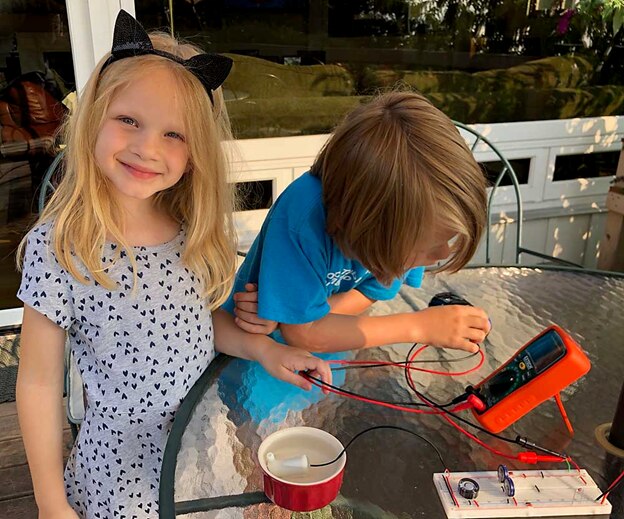
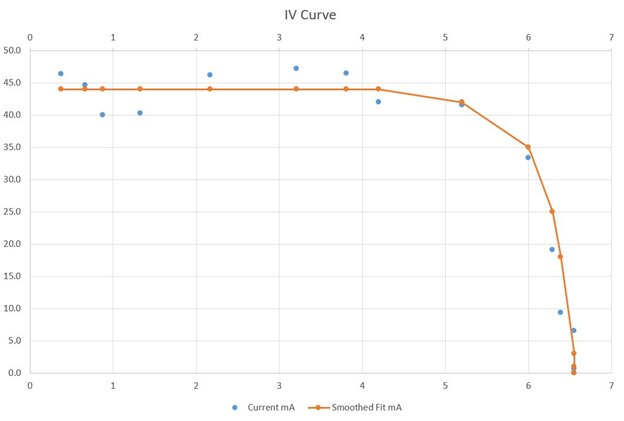

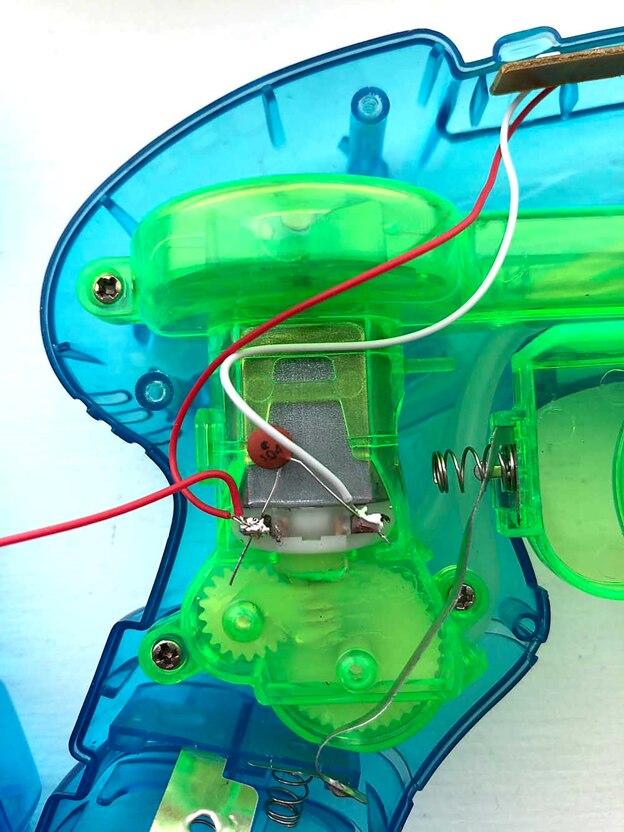
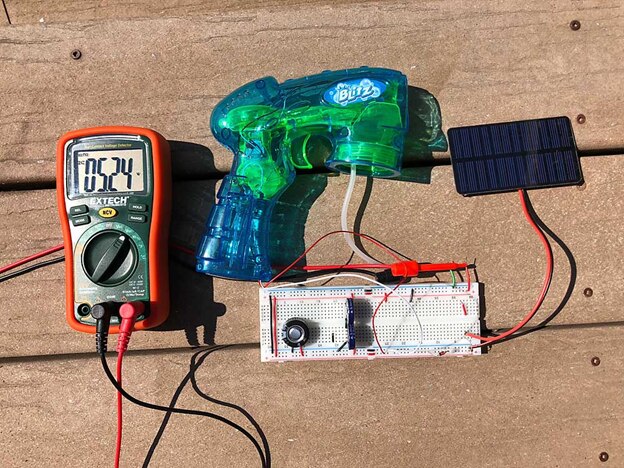
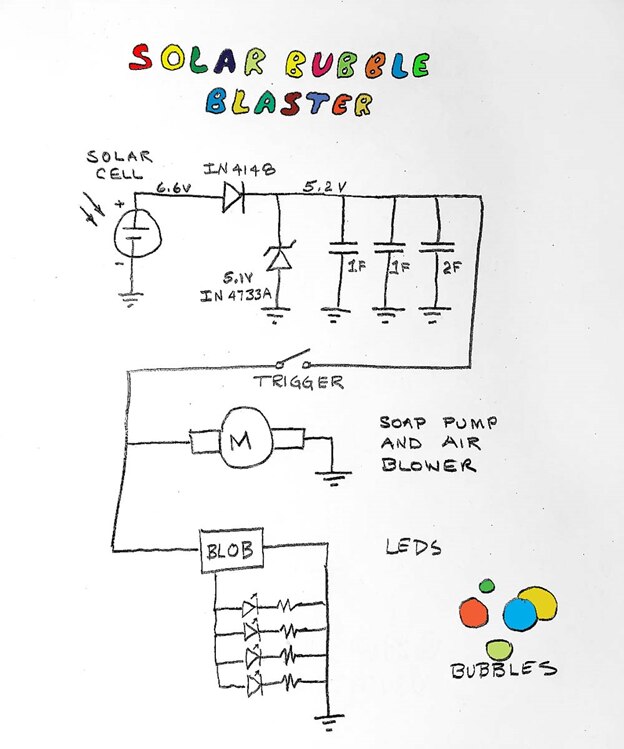
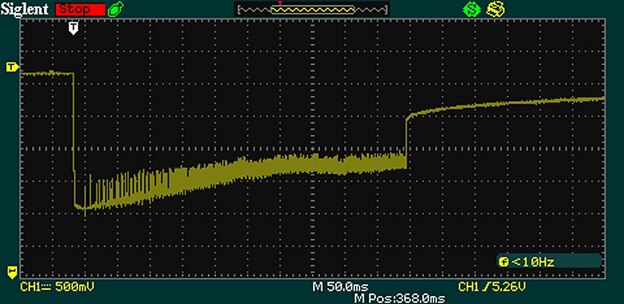
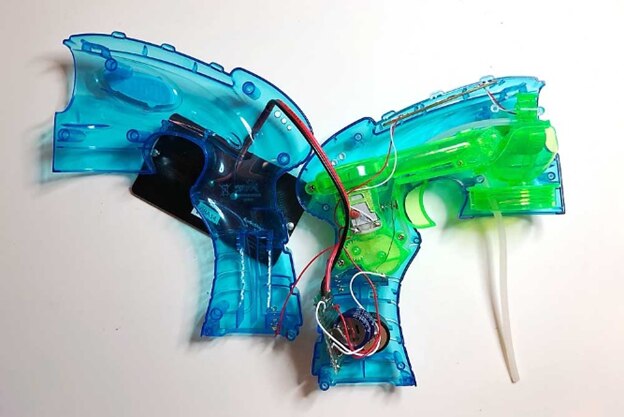
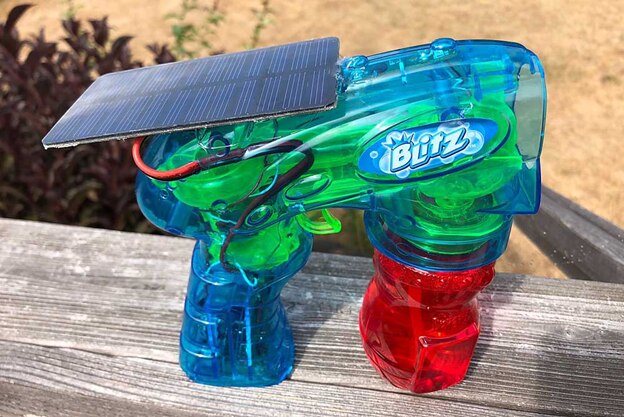
Top Comments
-

drmikeg
-
Cancel
-
Vote Up
+4
Vote Down
-
-
Sign in to reply
-
More
-
Cancel
-

michaelkellett
in reply to drmikeg
-
Cancel
-
Vote Up
+6
Vote Down
-
-
Sign in to reply
-
More
-
Cancel
-

ntewinkel
in reply to michaelkellett
-
Cancel
-
Vote Up
+4
Vote Down
-
-
Sign in to reply
-
More
-
Cancel
-

genebren
in reply to ntewinkel
-
Cancel
-
Vote Up
+4
Vote Down
-
-
Sign in to reply
-
More
-
Cancel
-

fmilburn
in reply to genebren
-
Cancel
-
Vote Up
+5
Vote Down
-
-
Sign in to reply
-
More
-
Cancel
Comment-

fmilburn
in reply to genebren
-
Cancel
-
Vote Up
+5
Vote Down
-
-
Sign in to reply
-
More
-
Cancel
Children